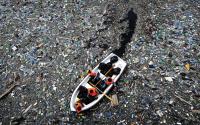Justin Blum23 April 2005
In the long struggle over drilling for oil in the Arctic National Wildlife Refuge, the Inupiat Eskimos who live in this outpost have played a key role. Their steadfast support for development is routinely cited as a major reason to allow oil companies into the refuge.
But when a delegation of U.S. senators and Cabinet secretaries landed on the unpaved runway here last month, an unusual sight greeted them: the first protest anyone can remember in Kaktovik. A handful of residents chanted slogans and unfurled signs opposing oil drilling, reflecting a small but significant shift in sentiment against proposed legislation that would permit drilling on the nearby tundra.
Residents in this town of compact wood houses and unpaved roads -- the only settlement within the refuge -- have long equated oil development with financial well-being. But a recent petition opposing drilling attracted the signatures of 57 of Kaktovik's 188 adults, and Mayor Lon Sonsalla said he is no longer certain where the majority stand.
Many Inupiats here question whether opening the refuge will endanger something they value most: their traditions -- especially the annual bowhead whale hunt, their strongest link to the past. They worry that drilling on land will eventually expand into the waters offshore, where residents have long opposed drilling for fear it will interfere with whale migration. Recent comments by Gov. Frank H. Murkowski (R) predicting that opening the refuge would lead to offshore development ignited their concerns.
After decades of debate, Congress appears closer than ever to approving drilling. The House on Thursday passed an energy bill that calls for drilling, and the Senate last month included it in a budget resolution. Supporters expect to iron out those differences in conference and include the refuge in the budget.
The opinions of natives in Kaktovik have become critical to the debate. While the town has no vote in the matter, members of Congress have been saying that Kaktovik strongly favors drilling, citing that as a reason for opening the refuge.
"My position is based on my experiences in Alaska when I visited the village of Kaktovik in 1995 and spoke to the Inupiat peoples, who greatly desire this opportunity for economic self-determination," Daniel K. Akaka (D-Hawaii) said last month on the Senate floor before voting for drilling. "To me, [the issue] is really about whether or not the indigenous people who are directly impacted have a voice about the use of their lands."
Spokesmen for Akaka and other lawmakers who support drilling said they have remained in touch with people from Kaktovik and think most still want drilling.
But some Inupiats here said lawmakers in Washington, four time zones away, have failed to take note of the shifting views.
Standing in her small grocery store, Carla Sims Kayotuk, 37, said she recently came out against drilling because of concern over the impact on hunting caribou and other animals used for food, art and clothing. "I've never really taken a stand before -- I've always supported the community position," Kayotuk said. "But I changed by mind this year. . . . They want to do the drilling where my family goes to hunt."
The importance of hunting can be seen all over Kaktovik, which is on an island in the refuge's coastal plain, where drilling would occur. On opposite ends of the island, near the water, lie two piles of whale bones left over from the annual hunt. The blubber and skin, called muktuk, was carved up and distributed throughout Kaktovik, where leftovers remain in residents' freezers.
Local artists use bones from the whale's mouth, called baleen, to create elaborate carvings. The hooded parkas and mittens worn by many Inupiats include fur and skin from wolf, caribou and seal that were killed by the people who wear them.
Some who live here said drilling would not harm these traditions and that environmentalists are stoking fears of offshore development to sway opinion.
Marie Kaveolook, 46, said she supports drilling for economic reasons. "People would have better jobs," said Kaveolook, an aide in the town's school, named after her father. "The place would get better services."
Kaveolook and others are concerned about cutbacks in school field trips and local government services, such as the health aide, because of declining oil production elsewhere on the North Slope. Much of the government's revenue comes from oil royalties.
The recent opposition movement was born in the cramped living room of Kaktovik resident Robert Thompson. He said he detected shifting opinion about drilling in February, after news reports of Gov. Murkowski's predictions about offshore drilling. Murkowski said oil companies are not interested in drilling off the refuge's coast because doing so would require laying expensive pipelines in the Beaufort Sea, around the refuge, which is now off-limits. But Murkowski said that with the refuge open, companies would find it economical to pipe the oil back to shore and through the refuge.
Thompson said the governor's logic helped persuade people to sign the petition. Offshore drilling is almost universally opposed in this 284-person town for fear that the noise associated with drilling would scare away whales or that a spill could pollute their habitat.
The annual whaling expedition has deep cultural roots here. The hunt unifies residents and provides food for three community celebrations and other meals.
Sheldon Brower, a 36-year-old worker at the power plant, proudly showed a video on his laptop computer of last year's hunt. His daughter Irene, 13, served as a lookout on his 18-foot boat.
"When you're bringing in the whale, the feeling you get is overwhelming," he said. "Practically the whole town is at the beach hollering. It's just one big, glorious, happy day. All the crews feel like we accomplished something -- we just fed the town."
Brower has long opposed drilling but decided to speak out for the first time recently after his wife, Mary Margaret, started campaigning against oil development. A lover of nature, he said roaming in the mountains is "like going to church for me" and that the experience would be altered by oil rigs. Brower also fears that onshore drilling will spark offshore drilling and scare away the whales.
"It'll change their migration," he said of offshore drilling's impact on whaling. "It'll destroy our culture completely. . . . Just the thought of it makes me sick to my stomach."
This time of year in Kaktovik and on the coastal plain, it's hard to tell where the treeless tundra ends and the Beaufort Sea begins. Everything is icy and white as a result of temperatures that can dip to 30 degrees below zero.
Oil money that has already flowed into Kaktovik has helped transform it from a place where wood was burned for heat and melted ice was used for water. The town has a modern power plant, cable TV and a water and sewer system that was installed late last year. Some residents drive trucks. Some buzz through town on snowmobiles.
Years ago, Kaktovik was a seasonal home for the Inupiat. After World War II, the U.S. government built a radar site on the island that brought jobs and many permanent settlers, including some white residents. Many of those jobs have since been eliminated, and government is now the biggest employer.
Some still support drilling because they think development would create jobs.
Katheryn Aishanna, 18, a high school senior, said she wants to remain in Kaktovik with her family and friends but worries about a future with declining oil revenue. Standing in the school, where snowdrifts almost obscure the view from some windows, Aishanna said she was convinced oil drilling and animals could coexist.
"Oil is good," she said. "We need oil. It's a natural thing. If it's part of the earth, it's not evil. It was put there by God for us to use."
Some Inupiats who live in Kaktovik and elsewhere on the North Slope have an added financial incentive to support oil. Shareholders in Inupiat corporations could profit from oil development rights on 92,000 acres in the refuge if it is opened -- a result of the Alaska Native Claims Settlement Act of 1971 and a subsequent land swap with the federal government. Some of those shareholders have been lobbying to open the refuge.
Kaktovik has long had to battle the image that it wants oil out of greed. Its residents are often contrasted with Gwich'in people who live just outside the refuge and oppose drilling for fear it would harm the caribou, which is central to their culture.
Sonsalla, Kaktovik's mayor, said people who live on the island aren't looking to get rich; they just want to maintain their way of life. And he questioned how government services could be maintained without new oil money.
The mayor said it is hard to predict the impact of drilling on Kaktovik and its traditions. "Is it going to be a big mess?" Sonsalla asked. "I hope not. Is it going to benefit the community? Hopefully."
http://www.washingtonpost.com/ac2/wp-dyn/A10253-2005Apr22?language=printer






